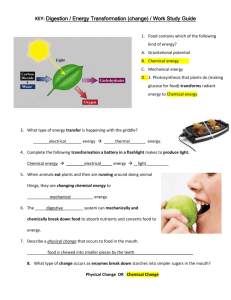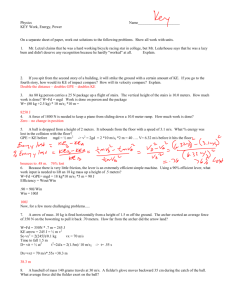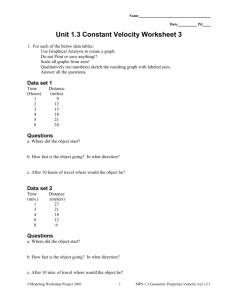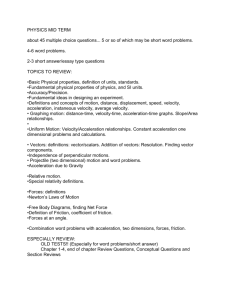Energy Notes
advertisement
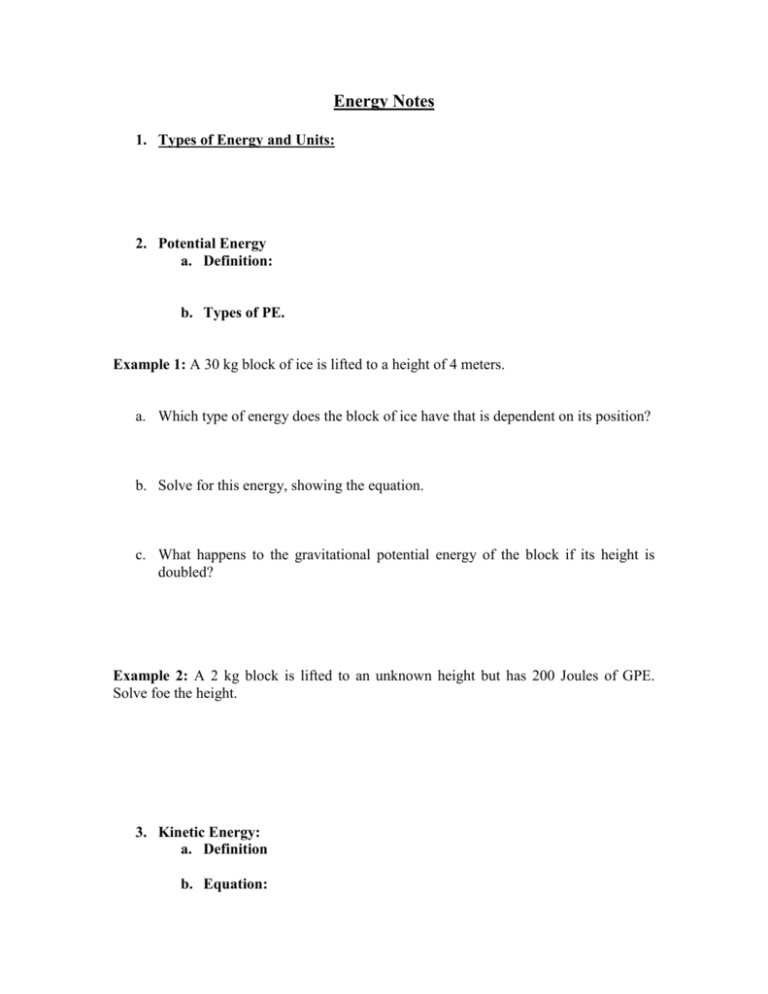
Energy Notes 1. Types of Energy and Units: 2. Potential Energy a. Definition: b. Types of PE. Example 1: A 30 kg block of ice is lifted to a height of 4 meters. a. Which type of energy does the block of ice have that is dependent on its position? b. Solve for this energy, showing the equation. c. What happens to the gravitational potential energy of the block if its height is doubled? Example 2: A 2 kg block is lifted to an unknown height but has 200 Joules of GPE. Solve foe the height. 3. Kinetic Energy: a. Definition b. Equation: Example 1: A 100 kg roller coaster has a velocity of 22 m/ when it reaches the bottom of a hill. a. Which type of energy does this roller coaster have that is dependent on its speed? b. Solve for this energy. c. What happens to the KE of the coaster if its velocity doubles? Example 2: A huge 10 kg arrow has 45 Joules of KE. What is its velocity? 4. Conservation of Energy Example 1: A 100 kg rock is dropped from a 50 m tall cliff. a. Which type of gravitational potential energy does it have at the top of the cliff? b. How much KE does it have at the top? c. Once released the GPE is decreasing. Why and where does it go? (Neglect air resistance.) d. How much GPE will it have the instant it strikes the ground? e. What is the KE does the rock have if all the GPE is converted to KE the instant before it strikes the ground? Example 2: A 4 kg snowball is dropped from a height of 20 meters. What is the velocity of the snowball at its lowest point? Example 3: Solve for the final velocity of the ball at the bottom of the incline. 5. Energy “Lost” to Friction Example 1: A 2 kg cart starts from rest at the top of 10 meter high ramp that has a length of 40 meters. The speed of the cart at the bottom of the ramp is 12 m/s. a. What is the total initial GPE + KE? b. What should the GPE + KE be at the bottom of the ramp? c. How much energy is lost to friction? 6. Work and Energy a. Definition(s) of Work b. Example 1: You push a 20 kg block up a ramp. What is the work done by you after you apply 150 N over 40 meters? 20 kg 20 m 40 m c. Example 2: A 2 kg mass is accelerated by a force of 40 Newtons over a distance of 3 meters, as shown. What is the work done by the force, and the final velocity of the block? d. Example 3: 500 Joules of Energy are used to lift a 60 Newton block a distance of 8 meters. How much work is done to overcome friction? D. Power 1. Definition: 2. Equation and Units 3. Example: A 20 kg mass is lifted a distance of 10 meters in 4 seconds. What is the power used? 7. Springs: a. Forces and Springs: (1) Hooke’s “Law”: b. Example: A spring is 0.4 meters long. It stretches to 0.6 meters when a 10 kg mass hangs from it. What is the spring constant of the spring? c. Energy and Springs: (1) Equation: Example: A spring loaded dart gun has a spring constant of 100 N/m. When shooting a dart the spring is compressed .25 m. What is the potential energy stored in the spring before it’s fired.
